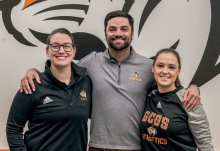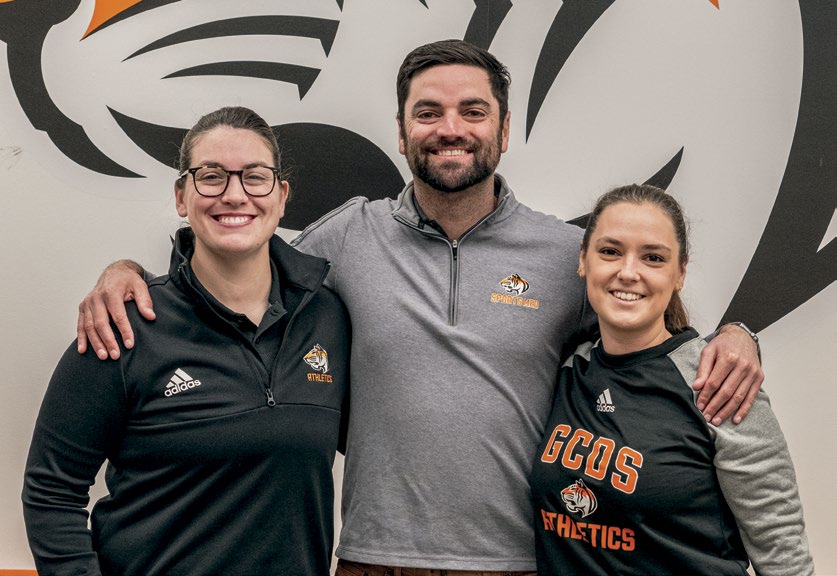
Director of Sports Medicine Patrick Curry joined Country Day 11 years ago. Over the years, as the school’s athletic program expanded, his role transformed from a part-timer to managing a team that offers a wide array of medical services.
“My role and the scope of the practice have gradually advanced to the point where we now have two other athletic trainers on the team. We cover numerous sports across two campuses and multiple local locations,” says Curry, who works alongside Abigael Green-Yotts and Sarah Quatela. “We are fortunate to have an Athletic Trainer present at practices, home games and many away games as well.”
GCDS recently received the designation of being a “Certified Safe Sports School” by the National Athletic Training Association (NATA). This important recognition underlines the school’s adherence to high standards in athlete care. “The certification pertains to athlete-to-athletic trainer ratio, comprehensive emergency action plans, and essential protocols, including concussion management and CPR training for coaches,” explains Curry.
The athletic training program at GCDS is multifaceted, focusing on prevention, emergency care, orthopedic evaluation, and rehabilitation. Athletic trainers must graduate from an accredited program, hold the Board of Certification credential, and be licensed in their state of CT. “We see ourselves as jacks of all trades,” says Curry.
As part of the pre-screening process, student athletes undergo optional heart screenings. On a couple of occasions, students were diagnosed with heart irregularities that had not been detected previously and were subsequently referred for cardiological care.
Curry emphasizes the importance of prevention: “We practice preventative medicine, including dynamic warm-ups and monitoring pre-participation physicals.” Such proactive measures are crucial in a setting where young athletes are developing.
In the case of injuries, Curry notes that athletic trainers often act as gatekeepers for orthopedic injuries. They work closely with doctors at the Hospital for Special Surgery, a renowned institution with a facility in Stamford. This collaboration extends beyond medical care and advice to educational training. “They’re an amazing resource,” he says.
For instance, if a student rolls their ankle, Curry asks, “Does this require an X-ray? Can we manage it in-house or not? We handle the bracing and management of the injury and the return-to-play process. During recovery, we provide a lot of rehabilitation here, supplementing with outside Physical Therapy if necessary.”
Curry and the team take pride in offering personalized care to each student. “We are here to figure out what is the best option for the athlete, whether that be making orthotics to help a dancer experiencing shin splints, or managing a soccer player’s return to academics and athletics after a concussion,” he says about their inclusive approach around diverse sports at GCDS.
Curry acknowledges that the decision to play or not is often challenging. Understanding the importance of sports in students’ lives, he aims to keep them engaged, even during recovery. “Sometimes, we need to hold students back to avoid worsening their condition. Other times, we can help support them with taping, bracing and treatments so they can participate, even if just partially to keep them as part of the team, ensuring they have that athletic experience. Either way, we need to advocate for them.”
It’s crucial to Curry that students see the athletic trainers as individuals who genuinely care about them. “We’re simply here to help. We build relationships with them so they see us as trustworthy. Kids visit us frequently. We aim to create an environment where people want to come in, hang out, and know that we’re always in their corner.”
To learn more about the Athletics Training Program, visit: www.gcds.net/athletics
#gcdsathletics


.jpg&command_2=resize&height_2=85)



.png&command_2=resize&height_2=85)


.jpg&command_2=resize&height_2=85)








.jpg&command_2=resize&height_2=85)



